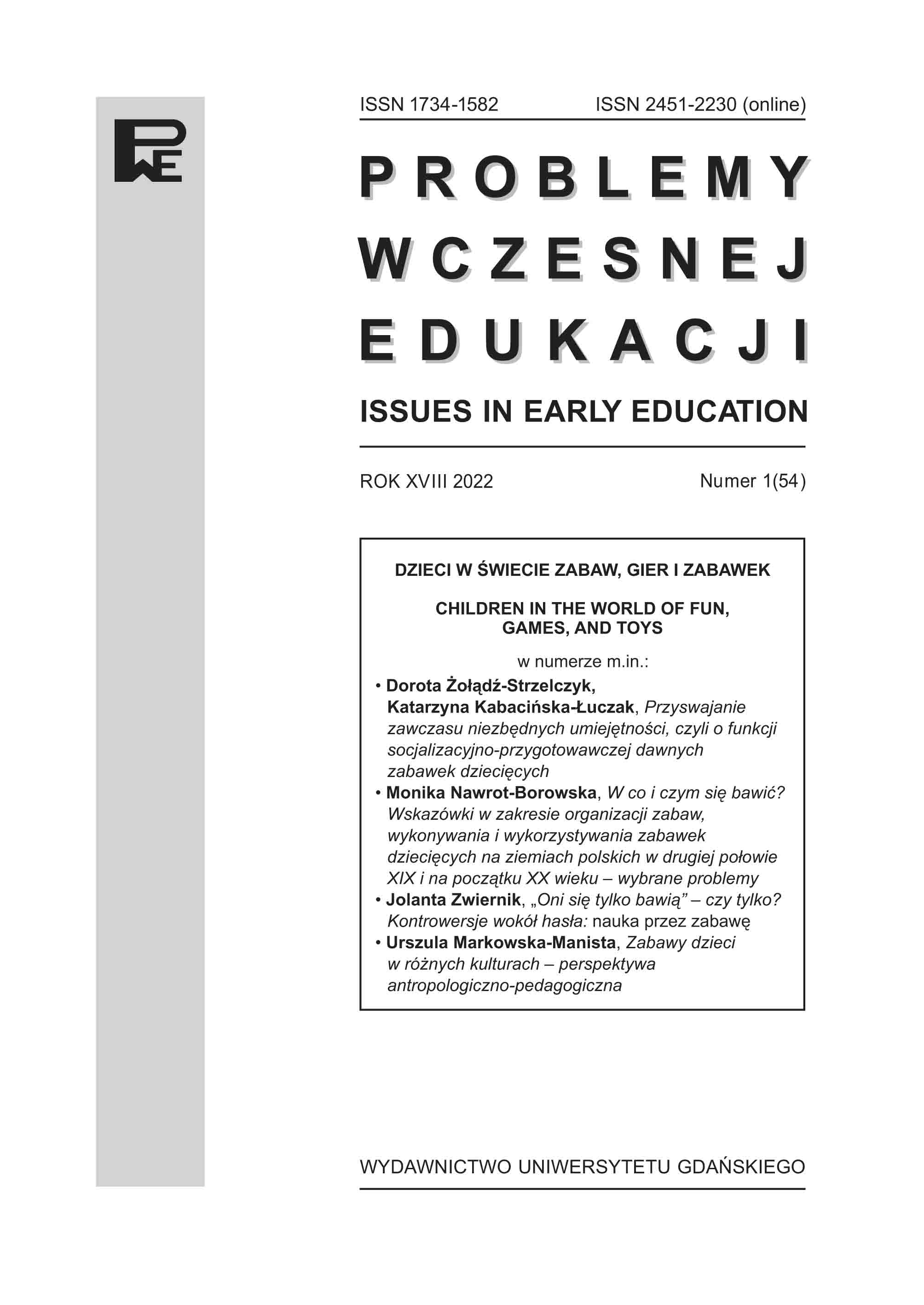Play and participation in preschool children’s project activities
DOI:
https://doi.org/10.26881/pwe.2022.54.07Słowa kluczowe:
projekt BRIDGING, dzieci, zabawa, działania zabawowe, partycypacja, wczesne nauczanie i opiekaAbstrakt
This article presents playful activities undertaken with children during the three years of the BRIDGING project. The authors try to show the pupils’ participation expressed through play in its different types. During the implementation of the project activities, it was important to have the attentive presence of adults who showed direction and tried to always remind children as well as other partners (from partner institutions) about the purpose of the playful activities. However, the educators did not show ready-made solutions and allowed the children to express their own opinions, to be creative and to work on their own, and to have fun. The cooperation of adult participants in the project – teachers, tutors and university lecturers – enriched the project with a diverse perspective on children’s activities, play and the issue of participation. The implementation of the BRIDGING project in Poland became an opportunity to develop the idea of equal involvement of adults and children. This idea has been disseminated in the local community, firstly among parents, and also among other people involved in the project through activities (including play activities) undertaken during the project.
Downloads
Bibliografia
Anderson-McNamee J.K. (2010), The Importance of Play in Early Childhood Development. A Self Learning Resource from Montana State University Extension. http://lanefacs.pbworks.com/w/file/fetch/65563699/Importance%20of%20Play.pdf, 5.08.2021.
Burghardt G. (2010), Defining and recognizing play. In: P. Nathan, A.D. Pellegrini (eds.), The Oxford handbook of the development of play. New York, Oxford University Press.
Burriss K.G., Tsao L-L. (2002), Review of Research: How Much Do We Know about the Importance of Play in Child Development? “Childhood Education”, 78(4).
Colucci E., Wright L. (2015), Moving children’s participation forward through Article 31 – The right to Play. “The Canadian Journal of Children’s Rights”, 2(1).
European Commission (2011), EU Agenda for the Rights of the Child. https://eur-lex.europa.eu/legal-content/EN/TXT/?uri=celex%3A52011DC0060, 5.11.2021.
Glassman M. (2000), Dynamic Aims: The Use of Long-Term Projects in Early Childhood Classrooms in Light of Dewey’s Educational Philosophy. “Early Childhood Research & Practice”, 2(1).
Harcourt D., Einarsdottir J. (2011), Introducing children’s perspectives and participation in research. “European Early Childhood Education Research Journal”, 19(3).
Hebert E.A. (2001), The power of portfolios: What children can teach us about learning and assess-ment. San Francisco, Jossey-Bass Education Series.
Huizinga J. (1949), Homo ludens: a study of the play-element in culture. London, Routledge & Kegan Paul.
Iacoboni M. (2009), Imitation, empathy, and mirror neurons. “Annual Review of Psychology”, 60.
Jans M. (2004), Children as Citizens. Towards a Contemporary Notion of Child Participation. “Childhood: A Global Journal of Child Research”, 11(1).
Juster A.H., Leichter-Saxby M. (2014), Citizens at Play: children’s participation through communi-ty-based opportunities for child directed play. “Global Studies of Childhood”, 4(2).
Köngäs M., Määttä K., Uusiautti S. (2021), Participation in play activities in the children’s peer culture, “Early Child Development and Care”, https://doi.org/10.1080/03004430.2021.1912743, 5.11.2021.
Lansdown G. (2004), Participation and young children. “Early Childhood Matters”, 103.
Ledin P., Samuelsson R. (2016), Play and Imitation: Multimodal Interaction and Second-Language Development in Preschool. “Mind, Culture, and Activity”, 24(1).
Martlew J., Stephen C., Ellis J. (2011), Play in the primary school classroom? The experience of teachers supporting children’s learning through a new pedagogy. “Early Years”, 31(1).
Maybin J. (2013), Towards a sociocultural understanding of children’s voice. “Language and Edu-cation”, 27(5).
O’Kane C. (2013), Children’s Participation in the Analysis, Planning and Design of Programmes. A guide for Save the Children staff. Save the Children, https://resourcecentre.savethechildren.net/node/7768/pdf/children_participation_in_programming_cycle.pdf, 27.08.2021.
Ostroff W.L. (2020), Teaching Young Children Remotely. “The Early Grades”, 73(3).
Pellegrini A.D. (2009), Research and Policy on Children’s Play. “Child Development Perspectives”, 3(2).
Ramsey D.S. (2020), Play & Playfulness: Definitions & Conceptions. https://mindsplain.com/wp-content/uploads/2020/08/play-playfulness-definitions-conceptions.pdf, 5.08.2021.
Roberts H. (2017), Listening to children: and hearing them. In: A. James, P. Christensen (eds.), Research with children: Perspectives and practices. New York, Routledge.
Roopnaire J.L. (2010), Cultural Variations in Beliefs about Play, Parent–Child Play, and Children’s Play: Meaning for Childhood Development. In: P. Nathan, A.D. Pellegrini (eds.), The Oxford handbook of the development of play. New York, Oxford University Press.
Singer D.G. (2006), Epilogue: Learning to play and learning through play. In: D.G. Singer, R.M. Golinkoff, K. Hirsh-Pasek (eds.), Play = learning: How play motivates and enhances children’s cognitive and social-emotional growth. New York, Oxford University Press.
Siraj-Blatchford I., Sylva K. (2004), Researching pedagogy in English pre-schools. “British Educational Research Journal”, 30(5).
Uprichard E. (2008), Children as ‘Being and Becomings: Children, Childhood and Temporality. “Children & Society”, 22(4).
White R.E. (2012), The power of play: A research summary on play and learning. Saint Paul, MN, Min-nesota Children’s Museum, https://academy.schooleducationgateway.eu/documents/1508261/0/power+of+play/ec599a0c-c9e5-405d-9c0c-c65872fe1e21, 5.11.2021.
Winters J. (2010), Children’s Participation in Planning and Regeneration. “Journal for Education in the Built Environment”, 5(2).
Zwiernik J. (2012), Podejście mozaikowe w badaniu doświadczania przez dzieci życia codziennego w instytucjach wczesnej opieki i edukacji. “Przegląd Badań Edukacyjnych”, 2(15).

 Uniwersyteckie Czasopisma Naukowe
Uniwersyteckie Czasopisma Naukowe





